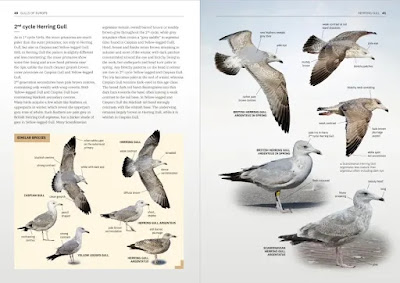Along comes another field guide for review - Gulls of Europe, North Africa, and the Middle East: An Identification Guide from Princeton Press. This new volume devoted to gulls and gulls alone was due to go on widespread sale from 23 November in the UK and April 2022 in the US but now it is finally on my desk with a new UK publish date of 14 December, the late arrival no doubt due to the pandemic.
The authors of “Gulls” are more than qualified to write the book. Peter Adriaens is an ecologist who has travelled widely to study and photograph gulls, including gull and tern colonies in Belgium and the Netherlands. Mars Muusse is a Dutch birder specializing in gulls and the founder of the gull identification website Gull Research Organization. Philippe J. Dubois is an ecologist, author, and editorial director of the journal Ornithos. Frédéric Jiguet is a conservation biologist at the National Museum of Natural History in Paris and director of the Center for Research in Biology and Bird Populations. His books include Birds of Europe, North Africa, and the Middle East here, https://anotherbirdblog.blogspot.com/2017/02/review-birds-of-europe-north-africa-and.html
In the last book review on Another Bird Blog I suggested we might be near the end days of bird field guides comprised of line drawn bird illustrations. “Europe’s Birds shows again how recent advances in camera optics and a photographer’s ability to fully exploit this progress have led to the demise of line drawn and painted guides, books that are not obsolete but now used by fewer birders.”
Those few words provoked comments from a number of birders who disagreed in preferring line drawings, the Collins Guide getting several mentions. That’s fair enough but Gulls of Europe is another almost entirely photographic guide, one that on first glance may appear to the reader to be comprised of line and colour drawings.
Close examination reveals that many of the 1200 colour photographs/illustrations are not line drawings but photographs that have been digitally processed to remove considerable backdrop so as to then emphasise and clarify the colours, shape and structure of the gull.
The method must be comparatively easy with gulls in flight but less so where the original photograph contained full and/or busy backgrounds. I must say that the processing has worked extremely well whereby the images are both comprehensive and impressive e.g. White eyed Gull at Pages 88-93.
And of course, because the images are taken from modern high quality photographs, they remain faithful to each individual bird and the time & date the camera clicked.
Two full pages of photographic credits provide testament to the number of photos and photographers involved in the book. The editors also picked wisely for the book’s cover with the main picture depicting a pair of beautiful Ross’ Gulls stood on northern ice.
In the Introduction the authors explain how the book uses ‘cycles’ to describe age classes, a term which helps to avoid problems with using calendar years or terms such as ‘first winter’, ‘second winter’ etc. It is not always realistic to divide plumages into strict and separate plumages when large gulls in particular have long and protracted moults that can last for months at a time. As the authors add, this cycle system has the added benefit of being applicable in both hemispheres where a species occurs both North and the South of the dividing line.
Hence the individual species’ accounts at Pages 26-314 of 45 gull species employ cycle nomenclature throughout. This might prove a little worrying, even perplexing on a first encounter by an unaccustomed reader, but on later reflection makes sense by using an alternative aging method that combines with a fuller understanding of gull plumage.
At Page 27 the authors wisely warn readers of exceptions to their cycle system in the few species accounts that differ from the norm set by the majority. The exceptions are Ivory Gull, Audouin’s Gull, White winged Gulls (Glaucous and Iceland), Pallas’s Gull, Baltic Gull and Heuglin’s Gull.
The geographical area and the species covered in 'Gulls' encompasses Europe, the Middle East and North Africa and so include all taxa from the wider Western Palearctic list, north, south, east and west, where such species have occurred at least once.
As one might expect each species account contains a precise summary of range together with a matching coloured map of acceptable size and clarity. The maps shown are for those taxa that breed within the Western Palearctic; the maps’ accuracy will I’m sure be subject to scrutiny, discussion and debate by gull enthusiasts with experience of more obscure species featured, e.g. Viking Gull, Steppe Gull. Or even Relict Gull, the latter a species so poorly known that there can be no map.
At £30 UK and $40 US the Gulls of Europe, North Africa, and the Middle East is more expensive than recent Princeton offers but a relatively small price to pay for birders ready to splash the cash on this latest must have book. And let’s face it many of those same birders would happily pay the same £30 and more for a tank full of juice to twitch a Steppe Gull that arrives on the coast of Aberdeenshire.
‘Gulls’ deserves to find a place on any serious birders book
shelf. For gull enthusiasts, gull gurus and those who simply can’t get enough
of gulls this book will already be on order for this underrepresented branch of
ornithological literature. I give top marks to Princeton for making the book available
to us all.
Gulls of Europe, North Africa, and the Middle East: An Identification Guide.
Price: $39.95 / £30.00 at Princeton Press.
ISBN: 9780691222837
Published (US): Apr 5, 2022
Published (UK): Dec 14, 2021
Copyright: 2022
Pages: 320
Size: 6.75 x 9.25 in.
Illus: 1,200 photos + illus.
Postscript. For Continental readers of Another Bird Blog who might prefer, there is a French Edition - Les Laridés du Paléarctique occidental - Guide d'identification des mouettes et des goélands.




































